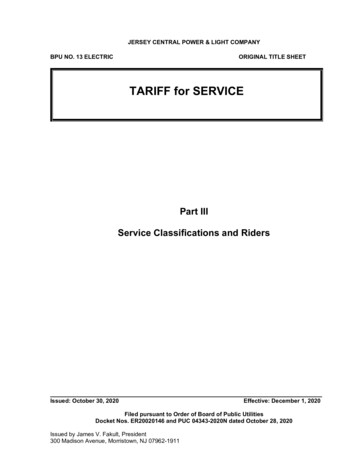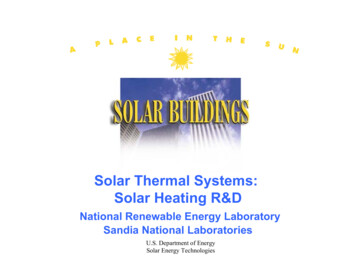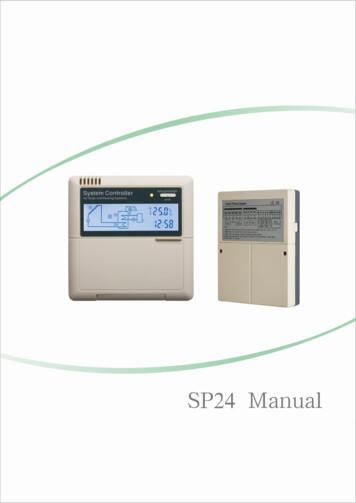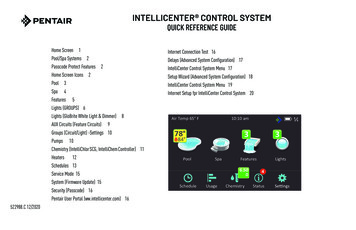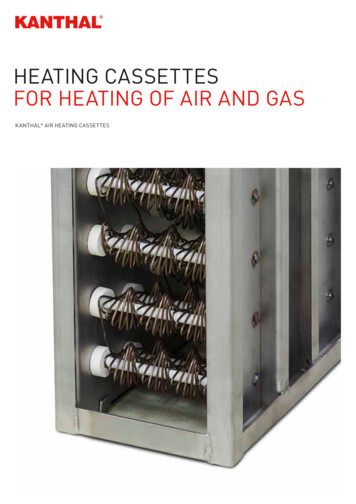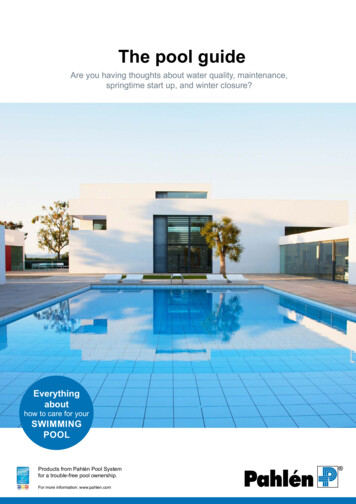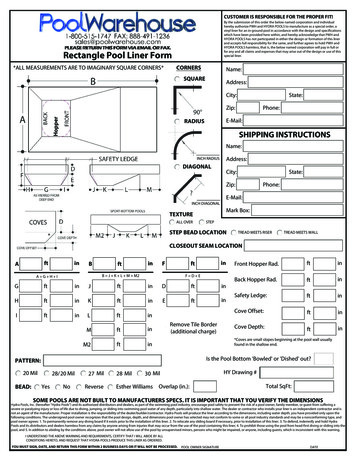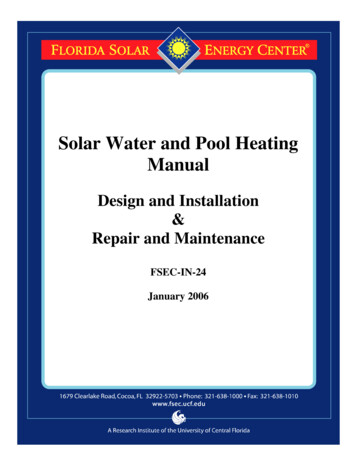
Transcription
Solar Water and Pool HeatingManualDesign and Installation&Repair and MaintenanceFSEC-IN-24January 2006
Solar Water andPool Heating ManualDesign and Installation&Repair and MaintenanceFlorida Solar Energy CenterCocoa, FloridaHTTP://WWW.FSEC.UCF.EDUFSEC-IN-24January 2006This document is protected by U.S.copyright, 2006, University of Central Florida.Permission is granted to reproduce all or part of this document for private and scholarly useprovided appropriate credit is given. All other rights are reserved. No part of this documentmay be sold or distributed for commercial purposes without license from the University ofCentral Florida, 12443 Research Parkway, Orlando, FL 32826.ii
Table of ContentsPrologue: A Brief History of Solar Water HeatingAcknowledgementsOverviewSection 1: Solar ConceptsModule: Solar Thermal Applications and TechnologiesSolar Thermal ApplicationsResidential applicationsCommercial applicationsAgricultural applicationsModule: Solar BasicsTerms and PrinciplesSun PathAtmosphereAngle of IncidenceAbsorptance vs. ReflectanceHeat TransferConductionConvectionRadiationTemperature Differential or Delta TConductionConvectionRadiationThermal MassApplying the BasicsCollecting and Converting Solar EnergyDaily VariationsSeasonal VariationsCollector OrientationTilt AngleHeat StorageAdditional System ConsiderationsSafetyAffordabilityMaterials Usediii
Section 2: Solar Water Heating SystemsModule: System TypesSystem TypesActive Direct SystemsDifferential ControlledPhotovoltaic ControlledTimer ControlledActive Indirect SystemsIndirect Pressurized SystemDrainback SystemPassive Direct and Indirect SystemsThermosiphon System, Direct or IndirectIntegral Collector Storage (ICS) SystemBatch SystemFreeze ProtectionIndirect antifreeze fluid circulationDrainingAutomatic Drain-downManual Drain-downDrain-backWater flowRecirculationFreeze protection valvesThermal massAuxiliary heatingModule: System ComponentsIntroductionCollectorsFlat-Plate CollectorEvacuated-tube collectorsIntegral CollectorsStorage TanksSingle Tank SystemsElectricGasMultiple-Tank SystemsPumpsPipingiv
Pipe hangersSolderIncompatible materialsPipe insulationControllersDifferential controllerSensorsPhotovoltaic (PV) ControllerTimer ControllerHeat ExchangersTube in tubeShell in tubeSingle- and double-wall heat exchangersHeat exchanger materialsHeat exchanger efficiencyHeat exchanger sizingHeat-Transfer FluidsExpansion TankValves, Gauges and Meters used in Solar SystemsAir VentTemperature-Pressure Relief ValvePressure Relief ValvePressure GaugeVacuum BreakerIsolation ValvesDrain ValvesCheck ValvesMixing or Tempering ValveAnti-Scald ValveFreeze-Protection ValvesOther ComponentsTemperature GaugesFlow MetersWater SupplySection 3: Solar Water Heating System InstallationModule: Collector MountingIntroductionCollector PositioningWind LoadingGround MountingRoof Mounted CollectorsRack MountingStandoff Mountingv
Direct MountingRoof Work ConsiderationsSite PreparationRoof PenetrationBracket Mounting and SealingCollector AttachmentRoof Piping and PenetrationsValvesPiping Collector ArraysModule: Component InstallationCollector-to-Storage Piping InstallationStorage Tank InstallationPump InstallationControls and Sensor InstallationDifferential ControllerTimer ControllerPhotovoltaic ControllerModule: System Installation Checkout and Start-Up ProceduresIntroductionPressure TestingFlushing the SystemTesting the Pump and ControlsCleaning UpInstructing the HomeownerSection 4: Solar Water Heating System TroubleshootingModule: Problem Assessment and System CheckoutProblem AssessmentThe Initial Service CallSystem RecordsWarranty CoverageService HistoryContractor LiabilityOverall CheckoutInvestigating Consumer Complaints - An ExampleLifestyle AnalysisCommon ProblemsControls and SensorsPumps and Flow RateThermosiphoning and Check Valvesvi
Freeze DamageOther Potential ProblemsShading the CollectorPipe Insulation DegradationEquipment SizingSystem CheckoutCollectorsBack-up heating elementPlumbing attached to the tankPressurized Indirect Systems Only:Control systemPump operationFlow in the collector loopControl system operationHeat-transfer fluids and the collector loopInspect the collectors up closeModule: Troubleshooting ChecklistIntroductionSection 5: Solar Swimming Pool Heating SystemsModule: Pool System Components, Installation and OperationEconomicsHeat Loss MechanismsEvaporative LossesConvective LossesRadiative LossesConductive LossesPassive Pool HeatingScreen EnclosuresWindspeed ReductionPool CoversTransparent Pool CoversLiquid FilmsOpaque CoversActive Pool HeatingLow-Temperature CollectorsFlat-Plate CollectorsPlumbing SchematicsFlow Control DevicesCorrosion ProblemsSizing Filter Pumps and Pipe RunsSizing Filtration and Circulation SystemsFilter Sizing Graphsvii
Pump Sizing GraphsSizing Connecting PipingExamplesPressure Drop Across the Valves and FittingsEnergy ConservationCollector InstallationProceduresPipingPiping to CollectorsPiping Between CollectorsFlow Control and Safety DevicesAutomatic valvesManual valvesActivating the SystemPurging the SystemPressure TestingTesting Control DevicesTesting Flow RatesTesting Temperature RisesInstructing the HomeownerAppendix 1: Chrome Dome Collector Sitting AidAppendix 2: FSEC Simplified Sizing procedure for Solar Domestic Hot Water SystemAppendix 3: Electric Water Heater CircuitryAppendix 4: Volt-Ohmmeter (VOM) or Multimeter OperationAppendix 5: Solar System Flow RatesAppendix 6: Tools for Services and Repairviii
Prologue: A Brief History of Solar Water HeatingSolar water heating has been around for many years because it is the easiest way to use thesun to save energy and money. One of the earliest documented cases of solar energy useinvolved pioneers moving west after the Civil War. They left a black pot in the sun all day tohave heated water in the evening.The first solar water heater that resembles the concept still in use today was a metal tank thatwas painted black and placed on the roof where it was tilted toward the sun. The conceptworked, but it usually took all day for the water to heat, then, as soon as the sun went down,it cooled off quickly because the tank was not insulated.Clarence Kemp of Baltimore patented the first commercial solar water heater in 1891. It wascalled the Climax. The Climax had several cylindrical water tanks of galvanized iron thatwere painted black. Kemp insulated the tanks in felt paper and placed them in a glasscovered wooden box for better heat retention. This invention earned Kemp the “father ofsolar energy in the United States” title.Solar water heating improved the lives of homeowners, especially during the summer,because it eliminated the need to heat water on the stove. Firing up the stove to heat waterwarmed the entire house. In the winter, the solar water heater was drained to protect it fromfreezing, and homeowners resumed heating water on the stove. Kemp claimed the Climaxcould be used from early April through late October in Maryland. In southern California, itcould be used year-round. High-energy costs in California made using free solar energy evenmore logical. By 1900, 1,600 Climaxes were installed in southern California.A design by William Bailey in 1909 revolutionized the industry with the first flat-platecollector. The most visible difference in his design was a separate collector and storage tank.The collector had a grid of copper pipes and was covered with glass. He added a metalabsorber plate to transmit the solar heat in the box to the water in the pipes. The storage tankwas insulated. Since these improvements kept the water warm morning and night, the solarhot water heater was called the Day and Night collector. The system could be connected to abackup gas heater, wood stove or coal furnace. An electric heater could be placed inside thestorage tank to heat the water automatically if it dropped below a preset temperature.Bailey’s business grew until a freak cold spell hit southern California in 1913. Copper pipesin the collectors froze and burst when the temperature dropped to 19 degrees Fahrenheit. Hesolved this problem by placing nonfreezing liquid in the collector pipes. This liquid traveledthrough a coil in the storage tank to heat the water. He sold more than 4,000 Day and Nightheaters by the end of World War I. The peak year was 1920 when more than 1,000 were sold.Solar hot water heater sales decreased when natural gas prices dropped and gas companiesoffered incentives, including free installation, to switch to gas. Bailey recognized the trendand used his experience to produce gas water heaters. His company made its last solar waterheater in 1941.ix
California’s gas discoveries nearly put an end to solar water heating there, but this was notthe case in Florida where solar was the only way to heat water cheaply. The Solar WaterHeater Company was established in Florida in 1923. By 1925, Miami’s population hadincreased to more than 75,000. Business flourished until Miami’s building boom subsided inearly 1926 and a hurricane struck the area in September. The plant closed shortly thereafter.In 1931, the plant reopened with an improved collector. Charles Ewald changed the woodenbox to metal to last longer in Florida’s humid environment. He also insulated the box andreplaced the steel tubing with more durable and better conducting soft copper. He discoveredthat soft copper withstood temperatures as low as 10 degrees Fahrenheit. Ewald added morepipe and placed it strategically for optimum efficiency. His design produced hotter water ingreater volume. He called it the Duplex.He also developed a method of matching the needs of the homeowner with the appropriatelysized collector and storage tank. This revived the industry in 1934. The following year, NewDeal legislation boosted home building and, in turn, the solar heating business. InexpensiveFHA Home Improvement Loans stimulated the market. By 1941, nearly 60,000 hot waterheaters had been sold in Florida. About 80 percent of Miami’s new homes had solar hotwater heaters, and more than 50 percent of the city used them. Solar water heaters were alsoused in north Florida, Louisiana and Georgia and in other parts of the world, including Japan.No matter how robust, the solar hot water boom wouldn’t last. At the start of World War II,the government put a freeze on nonmilitary use of copper, stalling out the solar hot waterheating market. After the war, the rise in skilled labor and copper prices made the collectorsless affordable. Electric prices dropped in the ’50s, making electric water heaters moreappealing. Installation and initial cost was also cheaper than solar hot water heaters. The tankwas automatic too. Solar water heating was not the same bargain anymore in the UnitedStates, especially when oil import limits were allowed to surpass 50 percent. A similarscenario happened later in Japan when it began importing oil in the ’60s. The peak year forJapan’s solar hot water sales was 1966.Throughout history, solar energy remained popular until abundant sources of fossil fuelbecame available. Interest in solar energy surged during oil embargoes in 1973-74 and 1979.Federal and state tax incentives led to rising sales in the early ‘80s. Sales flourished, but theindustry paid a high price for this brief period of prosperity. A lot of companies entered thesolar field just to make money and didn’t care about long-term relationships with theircustomers. This led to poor installations and gave the industry a bad reputation. After 1985,most of these fly-by-nighters left the solar field.Equipment has improved since the ’80s. Improvements were precipitated by bothcertification design review and experienced installers. There are more safeguards availablenow to ensure competent system design and installation, such as training programs andcertification. Training is important. Like any mechanical device, all these systems have to beserviced periodically for optimum operation. The Florida Solar Energy Center now has bothx
collector and system certification programs. The national Solar Rating & CertificationCorporation provides collector and system certification, as well as ratings for collectors andsystems.Today, more than 1.2 million buildings have solar water heating systems in the United States.This doesn’t include 250,000 solar-heated swimming pools. Japan has nearly 1.5 millionbuildings with solar water heating in Tokyo. In Israel, 30 percent of the buildings use solarheated water. Greece and Australia are also leading users of solar energy.There is still a lot of room for expansion in the solar energy industry. There are nogeographical constraints. For colder climates, manufacturers have designed systems thatprotect components from freezing conditions. Wherever the sun shines, solar water heatingsystems can work. The designs may be different from the early solar pioneers, but theconcept is the same.xi
AcknowledgementsPrincipal authors of this manual are Charlie Cromer, Bill Guiney and John Harrison.This manual is the result of the combined efforts and resources of a number of individualsand organizations. It and previous Florida Solar Energy Center (FSEC) solar water heatingmanuals have evolved from the original one developed by FSEC in the late 1970s. Thecurrent manual also incorporates, into one concise manual, the material that was in theprevious “Solar Water and Pool Heating Manual,” the “Solar Water and Pool Heating Designand Installation” and the “Solar Domestic Hot Water Systems Repair and Maintenance”manuals. The individuals involved in writing, reviewing and developing these manualsinclude former and current FSEC staff members: Subrato Chandra, Charlie Cromer, JohnHarrison, Bruce Holbaugh, Colleen Kettles, Tim Merrigan, Douglas E. Root and GerardVentre. Shelli Keisling converted all of the illustrations into electronic format for the currentmanual. Melinda Millsap and Mark Thornbloom editorially reviewed the manual andMelinda wrote the brief solar history. Individuals from the Florida solar industry includingBen Bentley, David Bessette and Bob Zrallack were instrumental in critiquing the currentmanual during its formative stages. They, and other members of the solar industry havealways been invaluable reference sources and partners in developing solar energy in Florida.The Florida Solar Energy Center is extremely grateful to the Florida Energy Office for theircontract assistance in developing this and previous manuals. Thanks are also accorded tomembers of the Florida Solar Energy Industries Association for their assistance in developingthe electronic version of the illustrations in this current manual.The current manual is comprised of various sections and modules within those sections. Withthis format, revisions can be made simply and quickly, as required. As is the case with everyFSEC document, comments on how this manual can be improved are always welcome.Technical comments or inquiries should be addresses to the Florida Solar Energy Center.xii
OverviewPurpose and ScopeThe intent of this manual is to equip the reader with the knowledge and skills needed todesign, install, operate and maintain the most common types of solar water heating systems.The manual serves as the textbook for the solar thermal course sponsored and conducted bythe Florida Solar Energy Center. It also functions as a study guide for those intending to takelicensing or certification exams.The manual presents an overview of solar thermal applications, provides basic informationon the principles of solar energy, reviews solar thermal technologies, and provides detailedinstruction on the safe, efficient installation of solar water heating and pool heating systems.The manual is divided into six sections, with each separated into individual modules.Section 1: Solar Concepts provides a basic understanding of solar thermal concepts Module: Solar Applications outlines the various applications that can be servedby the use of solar water heating systems Module: Solar Basics provides the reader with an understanding of the physicalprinciples employed in solar thermal technologies.Section 2: Solar Water Heating Systems focuses primarily on what are commonly calledsolar domestic hot water systems, which heat water. Module: System Types describes and illustrates the main types of solar systems,along with variations of each type as well as various freeze protection strategiesand design. Module: System Components details the principal components of solar waterheating systems and their function within the system.Section 3: System Installation covers the steps involved in installing a solar water heatingsystem. Module: Collector Mounting describes methods for properly placing andinstalling solar collectors. Module: Component Installation provides guidelines for the proper and safeplacement and connection of the remainder of solar system components. Module: System Installation Checkout and Start-Up, presents start-up andcheckout procedures for systems being installed.xiii
Section 4: Troubleshooting presents structured methods to follow in diagnosing andcorrecting solar water heating system problems. Module: Problem Assessment and System Checkout provides guidelines forassessing installed system problems. Module: Troubleshooting Checklist provides a comprehensive checklist fordetermining probable causes and the appropriate corrective actions.Section 5: Solar Swimming Pool Heating Systems is devoted to solar systems that provideheat for swimming pools. Module: System Components, Installation and Operation illustrates and describes thephysical elements of solar pool heating systems and provides guidelines for componentand system installation and operation.Appendix1. Crome Dome Collector Siting Aid is a tool for determining the best location for solarcollectors. Its simplicity and ease of use in the field make it ideal for installation and servicepersonnel.2. FSEC Simplified Sizing Procedure for Solar Domestic Hot Water Systems is aninvaluable guide in sizing solar water heating systems in Florida.3. Electric Water Heater Circuitry describes the electrical connections in a standard hotwater tank with two heating elements. An illustration shows where the high-limit protector islocated in the electrical circuits and how two thermostats prevent operation of both heatingelements simultaneously.4. Volt-Ohmmeter (VOM) or Multimeter Operation provides basic information on voltohm-meter and multimeter operation and includes a standard temperature and thermistorresistance table for 3,000 and 10,000 Ohm thermistors.5. Solar System Flow Rates describes two simple methods for checking solar system flowrates.6. Tools for Service and Repair lists the tools and equipment that field personnel generallyneed to service a solar system.xiv
Section 1: Solar Concepts provides abasic understanding of solar thermal concepts. Module: Solar Applications outlinesthe various applications that can beserved by the use of solar water heatingsystems Module: Solar Basics provides thereader with an understanding of thephysical principles employed in solarthermal technologies.
Solar Thermal Applications and TechnologiesSection 1Module: Solar Thermal Applications and TechnologiesA wide variety of applications can benefit from the use of solar technologies. Currently, theprincipal use of solar thermal systems in the United States is for hot water heating and poolheating. This is the main subject area of this manual – domestic solar water heating systems.Nevertheless, the use of solar technologies to provide space heating is also available in colderregions. Internationally, solar technologies are used for a myriad of applications, includingstandard water and pool heating as well as space heating, crop drying, cooking, and waterdistillation, to name but a few.This section provides a general overview of the various applications that can benefit from theuse of these technologies.Solar Thermal ApplicationsIn the United States the use of solar thermal systems is most predominant in the residentialmarket. This has a large impact on local and national energy usage and conservation.Traditionally, the primary use of solar in this sector has been for swimming pool anddomestic water heating as well as space heating.Residential applications Domestic hot waterSwimming pool and spa heatingSpace heatingWater purification/distillationAir ConditioningCommercial applications1-1
Solar Thermal Applications and Technologies HotelsSchoolsApartment and condominium complexesRecreation areas and campgroundsHospitals/Nursing homesRestaurantsLaundriesCar washesBeverage manufacturingCane sugar refiningCanning facilitiesFood processingMeat packing facilitiesPoultry farmsLight commercial businessesSummer campsRecreation areas and campgroundsIndustrial process heatAgricultural applications Crop dryingGreen housesDairy processingMeat processingAqua-cultureFood processingThink of some other applications that are not listed above and list them below. Once again, this manual concentrates on domestic hot water and pool heating. Nevertheless,as indicated above, other solar thermal applications are quite numerous.1-2
Solar BasicsSection 1Module: Solar BasicsUnderstanding solar thermal systems requires the knowledge of several energy terms andphysical principles. This chapter presents important terms and principles and shows howthey apply in solar thermal systems.Terms and PrinciplesInsolation is the amount of the sun’s electromagnetic energy that “falls” on any givenobject. Simply put, when we are talking about solar radiation, we are referring toinsolation. In Florida (at about sea level), an object will receive a maximum of around300 Btu/ft2hr (about 90 watts/ft2 or 950 watts/meter2) at high noon on a horizontal surfaceunder clear skies on June 21 (the day of the summer equinox).Sun PathOn the surface of the earth, insolation varies over time because of the planet’s dailyrotation, tilted axis and elliptical orbit around the sun. Imagine the sky as a dome (skydome) with the horizon as its edge. From this perspective, the sun’s path describes an arcacross the sky from dawn until dusk. This perceived path and its variations over time canbe plotted as in Figure 1, which shows the annual sun path from the perspective of 28degrees north latitude. This figure illustrates the seasonal changes in the sun's path for agiven location. It shows that the winter the sun rises in the Southeast, sets in theSouthwest, has a relatively short path and rises to a shallow 39 degree angle above thehorizon at noon. In the summertime, the sun rises in the Northeast, sets in the Northwest,has a longer path and rises to a much higher angle above the horizon.Figure 1. Annual Sun Path for 28º N Latitude (Orlando, Florida)1-3
Solar BasicsAtmosphereThe atmosphere absorbs certain wavelengths of light more than others. The exact spectraldistribution of light reaching the earth's surface depends on how much atmosphere thelight passes through, as well as the humidity of the atmosphere. In the morning andevening, the sun is low in the sky and light waves pass through more atmosphere than atnoon. The winter sunlight also passes through more atmosphere versus summer. Inaddition, different latitudes on the earth have different average “thicknesses” ofatmosphere that sunlight must penetrate. Figure 2 illustrates the atmospheric effects onsolar energy reaching the earth. Clouds, smoke and dust reflect some solar insolationback up into the atmosphere, allowing less solar energy to fall on a terrestrial object.These conditions also diffuse or scatter the amount of solar energy that does passthrough.Figure 2. Atmospheric Effects on Solar Energy Reaching EarthAngle of IncidenceThe sun’s electromagnetic energy travels in a straight line. The angle at which these raysfall on an object is called the angle of incidence (See Figure 3). A flat surface receivesmore solar energy when the angle of incidence is closer to zero (normal, perpendicular)and therefore receives significantly less in early morning and late evening. Because theangle of incidence is so large in the morning and evening on earth, about six hours of“usable” solar energy is available daily. This is called the “solar window.”1-4
Solar BasicsFigure 3. Angle of IncidenceAbsorptance vs. ReflectanceCertain materials absorb more insolation than others. More absorptive materials aregenerally dark with a matte finish, while more-reflective materials are generally lightercolored with a smooth or shiny finish. A golf ball covered with black matte paint placedin sunlight will absorb more solar insolation than a plain white golf ball.The materials used to absorb the sun's energy are selected for their ability to absorb ahigh percentage of energy and to reflect a minimum amount of energy. The solarcollector's absorber and absorber coating efficiency are determined by the rate ofabsorption versus the rate of reflectance. This in turn, affects the absorber and absorbercoating's ability to retain heat and minimize emissivity and reradiation. High absorptivityand low reflectivity improves the potential for collecting solar energy.Heat TransferBecause all natural systems seek a balance, heat always moves from warm (more energy)to cool (less energy). Heat moves by three methods: conduction, convection andradiation.ConductionConduction occurs when a solid material is heated. Molecules exposed to a heatsource become energized. These energetic molecules collide with neighboring,less-energetic molecules, transferring their energy. The greater the energy transferability of the solid’s molecules, the more energy they can transfer and the betterthe solid’s conductivity. Copper has high conductivity while glass has lowconductivity. If you place a heat source at the bottom of a copper tube and a glass1-5
Solar Basicstube at the same time, the top of the copper tube will become hotter quicker thanthe top of the glass tube.ConvectionLike conduction, convection occurs by molecular motion but in a fluid (such as agas or liquid), rather than in a solid. When a gas or liquid is heated, the energizedmolecules begin to flow. On earth, where gravity is a factor, the heated, lessdense fluid flows upward as cooler, more compact fluid moves down. Thisprocess of displacement continues as long as the heat source remains.RadiationRadiation occurs not by molecular action but rather by emission ofelectromagnetic waves, generally in the invisible, infrared spectrum. Becauseradiation does not rely on the presence of matter (molecules) for transport, it canoccur in a vacuum. Just as the sun radiates to the earth, a warm object on earthwill radiate infrared waves at night to objects in deep space. All objects with heatradiate to objects with less heat that are in a direct path.Figure 4. Illustration of Conduction, Convection and RadiationTemperature Differential or Delta TThe greater the difference in temperature between two points of an object or between twoobjects, the greater the driving force to move heat from the warmer to the cooler point.This applies whether the heat transfer method is conduction, convection or radiation.Consider the following examples:Conduction: Applying a 500oF heat source to the bottom of a copper tube willmake the top of the tube hotter and it will heat faster than if the heat source wereat 250oF.1-6
Solar BasicsConvection: A hot air balloon will rise faster if its air is 250 F rather than at150 F.Radiation: A camper sitting before a raging bonfire will feel much warmer than acamper sitting by the fire’s glowing embers.Thermal MassThermal mass is the measure of a material’s molecules ability to hold thermal energy.The higher the thermal mass, the material’s energy capacity, the more efficiently thematerial can store sensible heat. Rock and masonry are two such materials that have highthermal mass and are solids. Water is a fluid with good energy capacity, making it a goodthermal mass medium for energy storage.Applying the BasicsThe purpose of a solar heating system is to collect solar energy, convert it to heat, storethe heat, and provide the stored heat for an intended purpose. The efficiency of thesystem depends on how well the solar basics are applied.Collecting and Converting Solar EnergySolar collectors capture the sun’s electromagnetic energy and convert it to heat energy.The efficiency of a solar collector depends not only on its materials and design but alsoon its size, orientation and tilt.Daily VariationsAvailable solar energy is at its maximum at noon, when the sun is at its highest point inits daily arc across the sky. The sun's daily motion across the sky has an impact on anysolar collector's efficiency and performance in the following ways. Since the angle of incidence of the solar energy – measured from the normal(right angle) surface of the receiving surface – changes throughout the day, solarpower is lower at dawn and dusk. In reality, there are only about 6 hours ofmaximum energy available daily.The total energy received by a fixed surface during a given period depends on itsorientation and tilt and varies with weather conditions and time of day and season.Aiming the solar device to track the sun's rays to strike it at right angles (normal) all dayseems logical, but solar collectors are large and heavy and must be strong to withstandweather conditions. Tracking the sun requires considerably more hardware than doesfixed mounting. Most practical designs accept the loss of energy suffered through fixedmounting and use an orientation close to that which collects the most solar energypossible.1-7
Solar BasicsConsequently, fixed solar collectors are best positioned to face true south in the northernhemisphere and true north in the southern hemisphere. If the collector will beunavoidably shaded in the morning when inst
A Brief History of Solar Water Heating . Solar water heating has been around for many years because it is the easiest way to use the sun to save energy and money. One of the earliest documented cases of solar energy use involved pioneers moving west after the Civil War. They left a black pot in the sun all day to have heated water in the evening.



